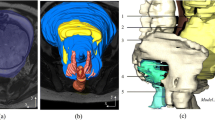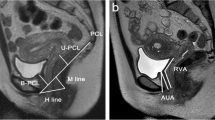Abstract
Introduction and hypothesis
The objective of this study was to measure the effects of pregnancy and parturition on pelvic floor muscles and pelvic organ support.
Methods
Levator ani, obturator internus, and coccygeus (COC) muscle volumes and contrast uptake were assessed by MRI of seven females prior to pregnancy, 3 days, and 4 months postpartum. Bladder neck and cervix position were measured dynamically with abdominal squeezing.
Results
The sides of three paired muscles were similar (p > 0.66). COC volumes were greater (p < 0.004) after parturition than before pregnancy or after recovery. COC contrast uptake increased (p < 0.02) immediately after delivery. Bladder neck position both in the relaxed state and abdominal pressure descended (p < 0.04) after delivery and descended further (p < 0.001) after recovery. Cervical position in the relaxed state before delivery was higher (p < 0.001) than postpartum but was unchanged (p = 0.50) with abdominal pressure relative to delivery.
Conclusion
In squirrel monkeys, coccygeus muscles demonstrate the greatest change related to parturition, and parturition-related bladder neck descent seems permanent.





Similar content being viewed by others
References
MacLennan AH, Taylor AW, Wilson DH, Wilson D (2000) The prevalence of pelvic floor disorders and their relationship to gender, age, parity and mode of delivery. BJOG 107:1460–1470
Lukacz ES, Lawrence JM, Contreras R, Nager CW, Luber KM (2006) Parity, mode of delivery, and pelvic floor disorders. Obstet Gynecol 107:1253–1260
Nygaard I, Barber MD, Burgio KL et al (2008) Pelvic floor disorders network. Prevalence of symptomatic pelvic floor disorders in US women. JAMA 300:1311–1316
Hoyte L, Schierlitz L, Zou KH, Flesh G, Fielding JR (2001) Two- and 3-dimensional MRI comparison of levator ani structure, volume, and integrity in women with stress incontinence and prolapse. Am J Obstet Gynecol 185:11–19
DeLancey JOL, Kearney R, Chou Q, Speights S, Binno S (2003) The appearance of levator ani muscle abnormalities in magnetic resonance images after vaginal delivery. Obstet Gynecol 101:46–53
Lienemann A, Fischer T, Anthuber C, Reiser M (2003) Functional MRI of the pelvic floor: postpartum changes of primiparous women after spontaneous vaginal delivery. Rofo Fortschr Geb Rontgenstrahlen Neuen Bildgeb Verhahr 175:1100–1105
Heilbrun ME, Nygaard IE, Lockhart ME et al (2010) Correlation between levator ani muscle injuries on magnetic resonance imaging and fecal incontinence, pelvic organ prolapse, and urinary incontinence in primiparous women. Am J Obstet Gynecol 202:488
Hoyte L, Jakab M, Warfield SK, Shott S, Flesh G, Fielding JR (2004) Levator ani thickness variations in symptomatic and asymptomatic women using magnetic resonance-based 3-dimensional color mapping. Am J Obstet Gynecol 191:856–861
Yousuf AA, Delancey JO, Brandon CJ, Miller JM (2009) Pelvic structure and function at 1 month compared to 7 months by dynamic magnetic resonance after vaginal birth. Am J Obstet Gynecol 201:514
Fielding JR, Dumanli H, Schreyer AG, Okuda S et al (2000) MR-based three-dimensional modeling of the normal pelvic floor in women: quantification of muscle mass. AJR 174:657–660
Rizk DE, Czechowski J, Ekelund L (2004) Dynamic assessment of pelvic floor and bony pelvis morphologic condition with the use of magnetic resonance imaging in a multiethnic, nulliparous, and healthy female population. Am J Obstet Gynecol 191:83–89
Coates KW, Galan HL, Shull BL, Kuehl TJ (1995) The squirrel monkey: an animal model of pelvic relaxation. Am J Obstet Gynecol 172:588–593
Coates KW, Gibson S, Williams LE et al (1995) The squirrel monkey as an animal model of pelvic relaxation: an evaluation of a large breeding colony. Am J Obstet Gynecol 173:1664–1670
Kramer LA, Gendron JM, Pierce LM, Runge VM, Shull BL, Kuehl TJ (2006) Magnetic resonance imaging of the levator ani in the squirrel monkey: a comparison of muscle volume between a cohort with pelvic organ prolapse and matched normals. Am J Obstet Gynecol 194:1467–1471
Pierce LM, Coates KW, Kramer LA, Bradford JC, Thor KB, Kuehl TJ (2008) Effects of bilateral levator ani nerve injury on pelvic support in the female squirrel monkey. Am J Obstet Gynecol 198:585
Bortolini MA, Drutz HP, Lavatsis D, Alarab M (2010) Vaginal delivery and pelvic floor dysfunction: current evidence and implications for future research. Int Urogynecol J Pelvic Floor Dysfunct 21:1025–1030
Pierce LM, Reyes M, Thor KB et al (2005) Immunohistochemical evidence for the interaction between levator ani and pudendal motor neurons in the coordination of pelvic floor and visceral activity in the squirrel monkey. Am J Obstet Gynecol 192:1506–1515
Pierce LM, Rankin MR, Foster RT et al (2006) Distribution and immunohistochemical characterization of primary afferent neurons innervating the levator ani muscle of the female squirrel monkey. Am J Obstet Gynecol 195:987–996
Pierce LM, Baumann S, Rankin MR et al (2007) Levator ani muscle and connective tissue changes associated with pelvic organ prolapse, parity, and aging in the squirrel monkey: a histological study. Am J Obstet Gynecol 197:60
Pierce LM, Reyes M, Thor KB et al (2003) Innervation of the levator ani muscles in the female squirrel monkey. Am J Obstet Gynecol 188:1141–1147
Stratford RR, Kuehl TJ, Coates KW, Thor KB, Shull BL, Pierce LM (2005) Evaluation of the squirrel monkey model of pelvic organ prolapse: anatomical and histological comparisons of the pelvic floor between women and squirrel monkeys. Int Urogynecol J 16(Suppl 2):S90
Handa VL, Lockhart ME, Kenton KS et al (2009) Magnetic resonance assessment of the pelvic anatomy and pelvic floor disorders after childbirth. Int Urogynecol J Pelvic Floor Dysfunct 20:133–139
Acknowledgments
The authors acknowledge the assistance of Dr. Bobby L. Shull with concept review and manuscript commentary, Ms. Gina Du Par for editorial assistance, and Drs. Rebecca Blackwood and Jennifer Lane for veterinary assistance and animal anesthesia. Funding and animal resources for this study were provided by Enderly Endowment for Research in Urogynecology, Noble Centennial Endowment for Research in Obstetrics and Gynecology (TJK), and the NIH Squirrel Monkey Breeding and Research Resource.
Conflicts of interest
None.
Author information
Authors and Affiliations
Corresponding author
Rights and permissions
About this article
Cite this article
Bracken, J.N., Reyes, M., Gendron, J.M. et al. Alterations in pelvic floor muscles and pelvic organ support by pregnancy and vaginal delivery in squirrel monkeys. Int Urogynecol J 22, 1109–1116 (2011). https://doi.org/10.1007/s00192-011-1443-y
Received:
Accepted:
Published:
Issue Date:
DOI: https://doi.org/10.1007/s00192-011-1443-y




